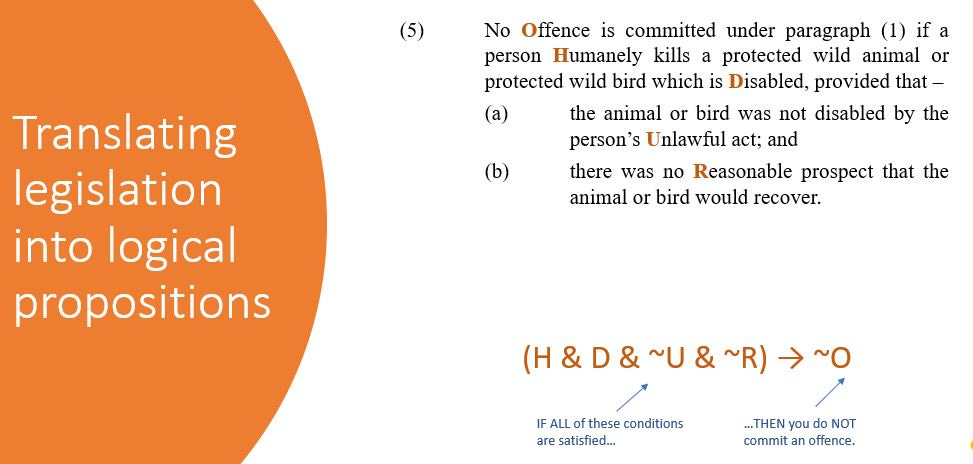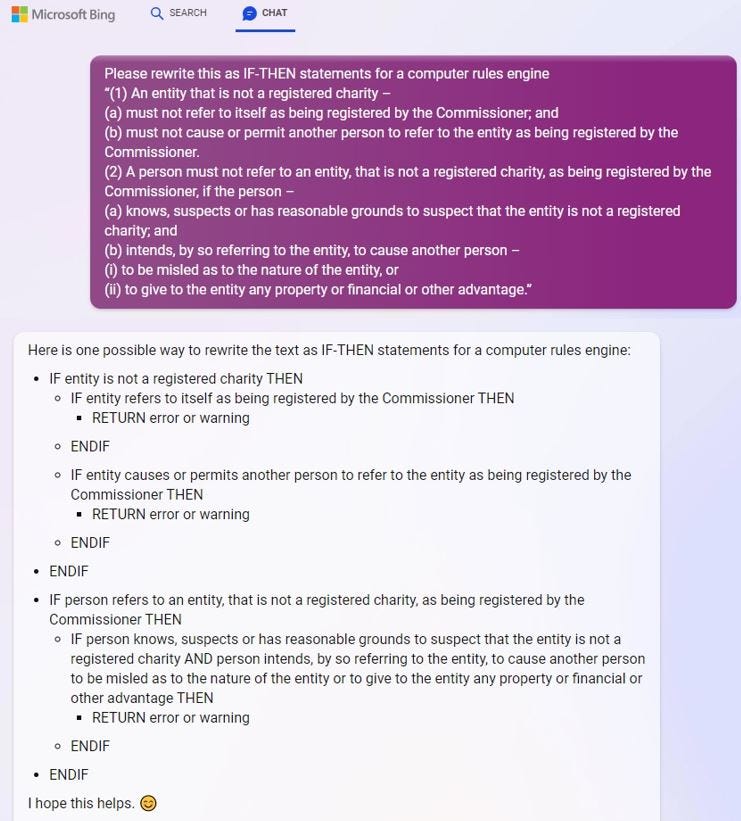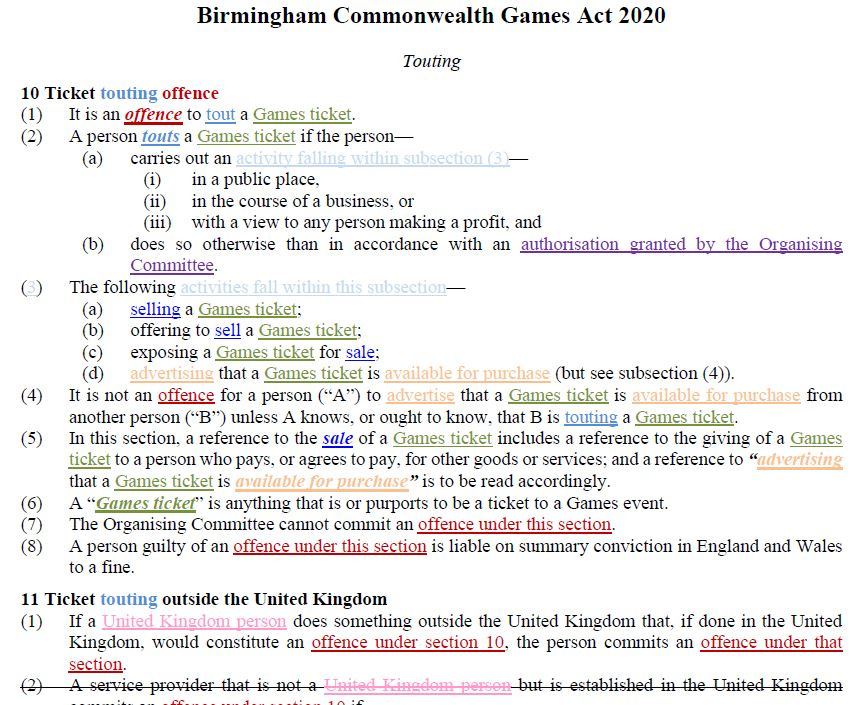We promised not to flood your inbox, but we have been a bit too shy recently, so here is an update on -
Logic workshops at CALC conferences
Generative AI (Bing & ChatGPT) for parsing legislative drafts
Making sure our trainee drafters are “born digital”
Colour-coding an Act, interns for the project and other news
Logic workshops at CALC conferences
Common drafting expressions that are logically equivalent and legally equivalent
We are about to head off for the conference in Cardiff for the European region of the Commonwealth Association of Legislative Counsel, where we will be running a session on formal logic and how it links to legislative drafting.
We will take participants (mostly legislative drafters) through the basics of “if”, “and”, “or” & “not” in formal logic. Then we will give them some exercises with “truth tables” and formal notation. This will demonstrate that there is more than one way to capture a logical relationship in formal logic - just as there is more than one way to draft a legislative provision to achieve the same legal effect.
Then we will look for feedback on our project by asking the drafters whether they agree that some ways in which we draft are legally equivalent as well as logically equivalent. We reckon “If a person drives, the person must wear a belt” is legally equivalent to “A person who drives must wear a belt”, or to “A driver must wear a belt” when coupled with a definition of “driver” as “a person driving”. We think they can all be marked up as if-then propositions - but we want to check whether any drafters see any problems with that.
In fact we are planning to take this presentation to the CALC Australasia-Asia-Pacific regional conference in August, to get more drafters’ views. We might also look at taking it to the Africa regional conference in October (maybe even also run it stand-alone for North America & Caribbean) if people are interested.
We will find some way of publishing a recorded version of the session after this week.
Generative AI (Bing & ChatGPT) for parsing legislative drafts
On and off, we have been trying out whether ChatGPT, and now Bing (and Bard soon), might be useful in giving legislative drafters an easy first go at producing an If-Then version of their drafts. See our posts on LinkedIn and Twitter.
We don’t think robots are yet going to replace drafters in drafting the text of legislation, and generative AI still makes plenty of mistakes (including “hallucinating” facts that are very convincingly set out, even with fake references). But we do think it could help where drafters feel they need a user-friendly helping hand with starting on parsing the logical structure of their drafts so that it can be made computer-readable.
We are trying to use the same questions/prompts, to compare the different systems. But we want to prompt them, when expressing the legislation in if-then terms, to think of “declarative logic programming” which is much better suited to capturing legislative logic than traditional programming.
It could be an easy way to produce an alternative version of your draft in which a computer can read & follow the logical structure. Or it could be a prompt to help you mark up the actual text of your draft to make that logical structure computer-readable directly from the enacted text.
We will report back once we have found time to generate some useful results.
Making sure our trainee drafters are “born digital”
We base our training for our trainee legislative drafters on the Commonwealth of Learning materials, which are used by Athabasca University and the University of the South Pacific for their postgraduate diplomas in legislative drafting. But we have added material from looking at modern takes on the structure of legislative sentences, updating from Coode to works like of “Fundamental Legal Concepts: A Formal and Teleological Characterisation” by Sartor, and “Logic and the Law: Philosophical Foundations, Deontics, and Defeasible Reasoning” by Governatori, Rotolo & Sartor.
We believe drafters in Commonwealth countries can start with a much slimmed down version of these sophisticated logical analyses that have been developed to cater for many types of law. We can take advantage of the relative narrowness of our subject matter (not trying to create law through international treaties, constitutions, contracts, case judgments and so on) and the way our modern Commonwealth style of drafting is already slimmed down and disciplined (particularly since we banished “shall”).
So we have been taking our trainees through the differences between provisions that take effect by operation of law and those that can be contravened. We have also looked at the way that “must” is sometimes used in constitutive provisions, like “an enforcement notice must contain information about the right of appeal”. If that “must” was contravened, the notice would not be imprisoned or fined, and instead the question is whether the reader is meant to understand that the notice then wouldn’t have the expected effects on the obligations of the person it is served on.
We are still working on the materials, but we will publish them at some point.
Colour-coding an Act, interns for the project & other news
Two of our team happen to have been teaching at Jersey’s Institute of Law on the University of London LLB’ “Legal System & Methods” module. Part of that involves the students learning how to find their way around a statute and cite the relevant provisions for what they say about a problem question. The University takes an extract from a piece of legislation, edits it slightly, and tells the students in advance that they will be asked a question on it in the exam. This year it is two offences from the Birmingham Commonwealth Games Act 2020, where constitutive provisions are nested inside each other in ways that many readers find difficult to navigate.
We took the extract and colour-coded it to help the students see how it fits together. Over the summer our project is going to look at turning the colour-coding into an if-then structure, preserving the wording of the provisions, and then feed it into a computer (maybe using Excel’s if-then formulae) to produce answers that also use the wording of the provisions. But we won’t be able to publish the results before autumn as some students will end up using the same Act extracts in their resits.
Meanwhile we have arranged for one student from the Institute of Law, and one from the Government of Jersey’s Intern Scheme, to join us as interns for 6 weeks each over the summer to work on the project.
We have also arranged for two of our staff to attend the “AI and Law” summer school run by the European University Institute.
We have been talking to RegGenome (a spin-off from a project of Cambridge University) about using our legislation in their new system for comparing the world’s financial legislation and regulation. We are hoping that will go live soon so we can share links.
Other work still ticking over includes -
talking to Jersey’s Financial Services Commission about their published plans to make their regulatory codes of practice machine-readable;
working on a new Interpretation Law to be fit for the digital age;
adapting the UK’s “Common Legislative Solutions” for Jersey and looking at parsing some standard provisions, possibly through setting up projects with Flinders University students; and
talking to AustLII about their DataLex system.
More news on these when there is something to report. In the meantime we are looking at whether Substack’s new Notes feature might be useful for smaller news items.
Thanks for reading.







